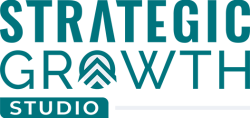Confused by funding lingo? Here’s a plain-English funding glossary to help you speak the same language as your lender, investor, or advisor—and build a truly investor-ready business plan.
Why This Funding Glossary Matters
If you’re preparing to raise capital—whether through a bank, SBA loan, or private investor—understanding the terminology is just as important as knowing how to write a business plan.
Founders who sound prepared are taken more seriously. This glossary is built specifically for small business owners and entrepreneurs navigating business plan development and funding conversations for the first time—or the first time seriously.
How to Use This Funding Glossary:
Start by reviewing the terms most relevant to your funding journey. If you’re pursuing a loan, focus on the Lending Metrics section. If you’re writing a business plan for funding, use this as a checklist for your financial projections, executive summary, and use-of-funds breakdown.
Core Financial Terms
1. Capital Expenditure (CapEx):
Money spent on long-term assets like buildings, equipment, or renovations. CapEx is a key component of a traditional business plan format.
2. Operating Expense (OpEx):
Ongoing costs like rent, utilities, payroll, and software subscriptions. A strong business plan template will detail OpEx as part of financial forecasting.
3. Gross Profit:
Revenue minus the cost of goods or services sold (COGS).
4. Net Profit:
What’s left after all expenses, including OpEx and taxes, are deducted from revenue.
5. Cash Flow:
The movement of money in and out of your business. Most bank-ready business plans include monthly cash flow forecasts.
6. Burn Rate:
How quickly you’re spending down available capital. Especially relevant to lean startup business plans.
7. EBITDA:
Earnings Before Interest, Taxes, Depreciation, and Amortization. A measure of operational profitability.
8. Working Capital:
Current assets minus current liabilities. Indicates short-term financial health.
Funding Structures & Sources
9. SBA Loans:
Small Business Administration loans offer government-backed financing options for various needs. The most common is the SBA 7(a) Loan, used for working capital, equipment, and expansion. Others include:
-
- SBA 504 Loan: Ideal for real estate and fixed assets.
-
- SBA Microloan: Small-scale loans under $50K, often through nonprofits.
-
- SBA Express Loan: Faster approval but lower loan caps.
-
- SBA CAPLines: Designed for seasonal or contract-based cash flow needs.
10. Term Loan:
A lump-sum loan repaid over a fixed period—typically used for specific investments.
11. Line of Credit:
Flexible financing that allows you to draw and repay funds as needed (like a credit card for your business).
12. Equity Financing:
Raising capital by selling ownership in your company.
13. Angel Investor:
An individual who provides early-stage funding, often in exchange for equity.
14. Convertible Note:
A loan that may convert into equity later, often used in early funding rounds.
15. Bridge Loan:
Short-term financing to “bridge the gap” between now and a future funding event.
Key Lending Metrics
16. DSCR (Debt Service Coverage Ratio):
Measures your ability to repay debt. A DSCR of 1.25 means you have $1.25 in income for every $1.00 of debt obligation—usually the minimum for SBA loans. When your loan officer asks about DSCR, they’re looking for a cushion of income above your debt payments. This figure is a core element in any financial projections business plan section.
17. LTV (Loan-to-Value):
Ratio of the loan amount to the appraised value of collateral. Lower LTV = lower lender risk.
18. Collateral:
Assets pledged to secure a loan. Can include real estate, equipment, or inventory.
19. Personal Guarantee:
A legal promise that the business owner will repay the loan if the business cannot.
20. Creditworthiness:
Your (or your business’s) ability to repay, based on financial history, income, and credit score.
21. Use of Funds:
A breakdown of exactly how loan or investor money will be spent. This is critical to loan approval.
22. Liquidity:
Your business’s ability to meet short-term obligations using readily available assets (like cash or accounts receivable). A key sign of financial health and a major factor in lender risk assessment.
Startup & Planning Vocabulary
23. TAM / SAM / SOM:
Market sizing terms:
- TAM: Total Addressable Market
- SAM: Serviceable Addressable Market
- SOM: Serviceable Obtainable Market
Understanding these helps you create a compelling market analysis business plan section.
Read more about how to size your market →
24. Break-even Point:
The moment your revenue covers all fixed and variable costs and you stop losing money. This point is often referenced in startup and small business financial models.
25. Forecast vs. Budget:
- A forecast is a prediction of future results based on assumptions.
- A budget is a spending plan based on what you want to happen.
Both are essential tools within any SBA business plan, resources, or outline.
Final Thought: Don’t Just Sound Smart — Be Prepared
Understanding the terms in this funding glossary gives you credibility. But having a business plan that includes them properly—and models them out—makes you fundable.
Need a business plan for funding that checks every box for lenders and investors?
We build bank-ready and investor-ready business plans with strategy baked in.
Frequently Asked Questions: Business Funding Terms
What’s the most important metric for SBA loan approval?
Most lenders consider DSCR the most important factor. A DSCR of 1.25 or higher is typically required for SBA approval.
How are CapEx and OpEx different?
CapEx refers to long-term investments like buildings or equipment. OpEx refers to regular, recurring operating costs like payroll and utilities.
Why does liquidity matter to a lender?
Liquidity shows how quickly you can access cash to meet obligations. Strong liquidity reduces perceived lending risk.
What’s the difference between a forecast and a budget?
A forecast is a prediction. A budget is a spending plan. Lenders prefer forecasts backed by realistic assumptions and market research.




